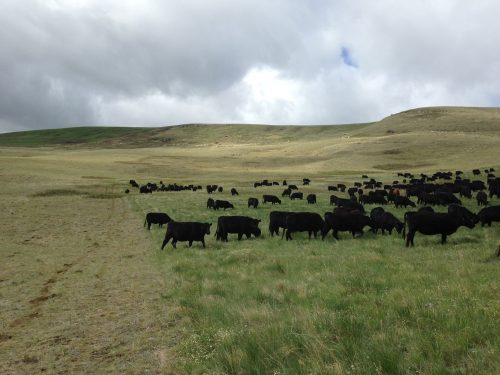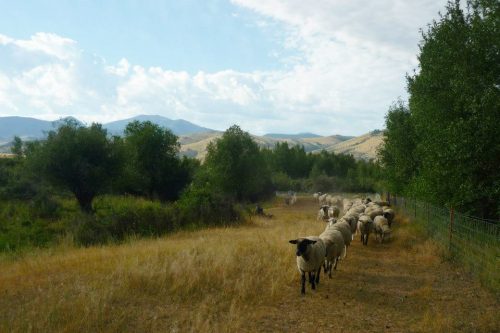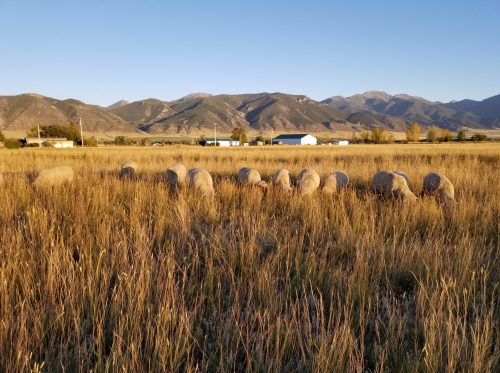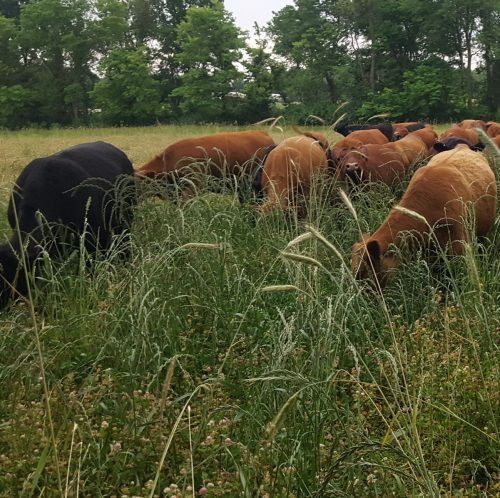By Lee Rinehart, Sustainable Agriculture Specialist, NCAT Northeast
Back in the late 1990s, I was a new county Extension agent in Texas. I met a Brangus rancher who became a friend and demonstration cooperator, and I pitched him a topic that he became immediately interested in. We laid out 11 paddocks and began grazing 24 heifers in a daily rotational system. The lightbulb went on in my head when I looked about the paddock to assess how much they had grazed, and I noticed that all of the curly dock had been stripped bare. What I had observed was a change in grazing behavior, caused by a controlled grazing system that decreased the heifers’ grazing selectivity.
Fast forward to 2020, and the landscape of managed grazing has changed. We understand that we are dealing with a biological system driven by diversity. The powerful principles we learned from management intensive grazing have been refined into an adaptive system of livestock production that can actually regenerate the soil, the water cycle, and the land.
Adaptive grazing improves forage availability and ecosystem functioning, and strengthens grazing landscapes with diversity and resilience. ATTRA has brought together a suite of resources for farmers and ranchers, of all scales and for all species of grazing animals, who are interested in transitioning to an adaptive grazing system.
Consulting the Expert
Dr. Allen Williams, a leading expert in regenerative, adaptive grazing, recommends providing extended periods of rest between short, high stock-density grazing periods on diverse pastures.
This allows for optimum recovery of forages and increases overall forage dry matter production. It also contributes significantly to soil health through the addition of organic matter.
Williams (2019) speaks of three principles that characterize this system:
- The Principle of Compounding – our actions result in a series of compounding and cascading events that are either positive or negative.
- The Principle of Diversity – highly diverse and complex pastures create positive compounding effects.
- The Principle of Disruption – planned, purposeful disruptions build resilient systems with more vigor and diversity and create positive compounding effects.
As such, adaptive grazing is goal-oriented, focuses on stock density and not stocking rate, and is necessarily flexible.
Ewes making their way from night camp to the day’s grazing in a dryland meadow. Photo: Dave Scott, Montana Highland Lamb
Rotations, grazing-residue heights, rest periods, and grazing seasonality are never the same throughout the year. This grazing system uses frequent movement and adequate pasture rest for plant root-system recovery, and is highly reliant on temporary fencing (Williams, 2016).
ATTRA Can Help You With Your Grazing System
ATTRA offers detailed guidance on developing your grazing system through instructional videos, podcasts, and in-depth publications.
Videos
Video Series: Adaptive Grazing with Allen Williams
Recorded in November 2019 at the Piney Woods School in Mississippi, Allen Williams leads participants on a pasture walk and discusses the various elements good grazing and pastured livestock production with his engaging style.
- Soil evaluation, aggregation, and biology
- Mycorrhizal fungi
- Forage density, paddock size, and animal movement
- Forbs and medicinal compounds
- Animal density, nutrition, and parasite management
- Setting up an adaptive grazing system
Spring Pasture Management series with Margo Hale, NCAT Southeast Regional Director, Prairie Grove, Arkansas.
- Winter Paddock Recovery
Margo Hale provides a short tour of one of her pastures as spring approaches, and discusses how she manages winter paddock recovery after feeding round bales. - Forage Diversity in Pastures
Hale discusses the importance of forage diversity in pastures to provide high quality forage and to build pasture soil health.
Regenerative Grazing from the Ground Up highlights Greg and Forrest Stricker’s dairy herd grazing and their use of warm season annuals to supplement their herd with high quality forage while building soil health. Filmed at a Pennsylvania Association for Sustainable Agriculture Field Day at Spring Creek Farms in Wernersville, PA, September 19, 2019.
Podcasts
Allen Williams and Adaptive Stewardship Management Grazing
https://attra.ncat.org/allen-williams-and-adaptive-stewardship-management-grazing-podcast/
This podcast, recorded in November 2019, provides a “big picture” view of pastured livestock production and offers insight on the development of Allen’s techniques.
Regenerative Grazing: Outcomes and Obstacles
https://attra.ncat.org/regenerative-grazing-outcomes-and-obstacles/
In this episode, Dave Scott and Lee Rinehart, both specialists with NCAT’s ATTRA – the National Sustainable Agriculture Information Service – have a conversation about regenerative grazing.
Publication
Pasture, Rangeland, and Adaptive Grazing (IP306D)
https://attra.ncat.org/product/pasture-rangeland-and-grazing-management/
This publication, published in 2020, contains an explanation of the principles and practices, and further resources, for the kind of grazing Allen advocates in the videos. It’s a good supplement to the videos for digging deeper into the intricacies of grazing and pasture management.
Nutrient Cycling in Pastures (IP136D)
https://attra.ncat.org/product/nutrient-cycling-in-pastures/
This publication looks at the pathways and drivers that move nutrients into, out of, and within pasture systems. It attempts to provide a clear, holistic understanding of how nutrients cycle through pastures and what the producer can do to enhance the processes to create productive, regenerative, and resilient farm and ranch systems. Effective management of nutrient cycling in pastures is simply understanding how nature cycles nutrients in natural grasslands and then mimicking those processes.
Building Healthy Pasture Soils (IP546P)
https://attra.ncat.org/product/building-healthy-pasture-soils/
This publication is a supplement to ATTRA’s Managed Grazing Tutorial session on Pasture Fertility, and introduces properties of soil, discusses evaluation and monitoring of soil quality, and introduces grazing management principles and techniques that promote healthy soil.
Tutorial
Managed Grazing
https://attra.ncat.org/tutorials/
Have you heard that changing the way you manage your grazing animals can change the condition of your land and finances for the better? Interested in finding out more about how managing your livestock can improve your soil health, your pasture condition and your bottom line? This tutorial features sessions taught by National Center for Appropriate Technology specialists who are also livestock producers. They share years of experience managing their own pastures to inspire you to start wherever you are and build or refine your own managed grazing systems. Detailed presentations and real-world examples will get you on the road to managed grazing.
References
High stock density removes grazing selectivity thereby utilizing forages more efficiently, and returns large amounts of carbon back to the soil through trampling of uneaten forage. Photo: Understanding Ag, LLC
Williams, Allen. 2016. Adaptive Grazing and Relationship to Soil Health (presentation). www.sfa-mn.org/wp-content/uploads/2016/02/Allen.2017.DirtRich-1.pdf.
Williams, Allen. 2019. Personal Communication.





